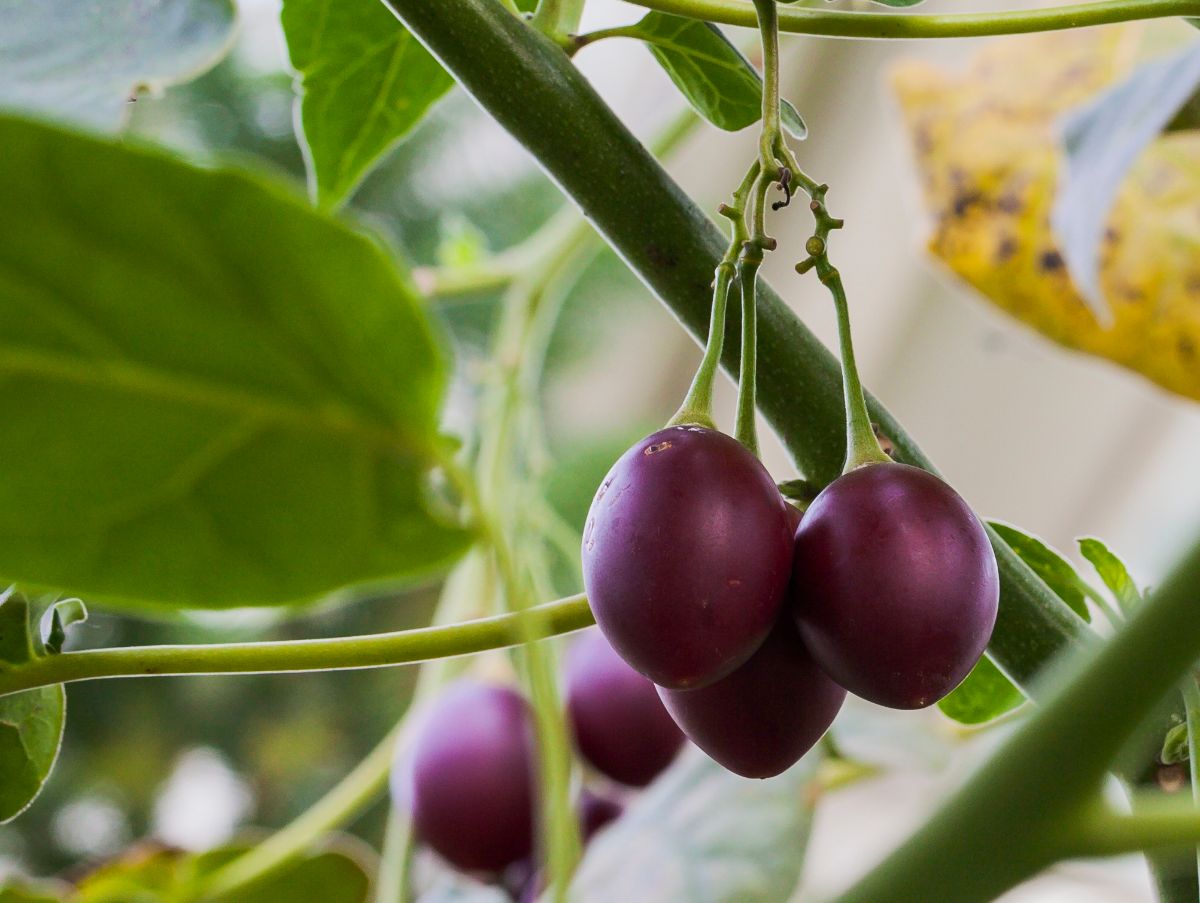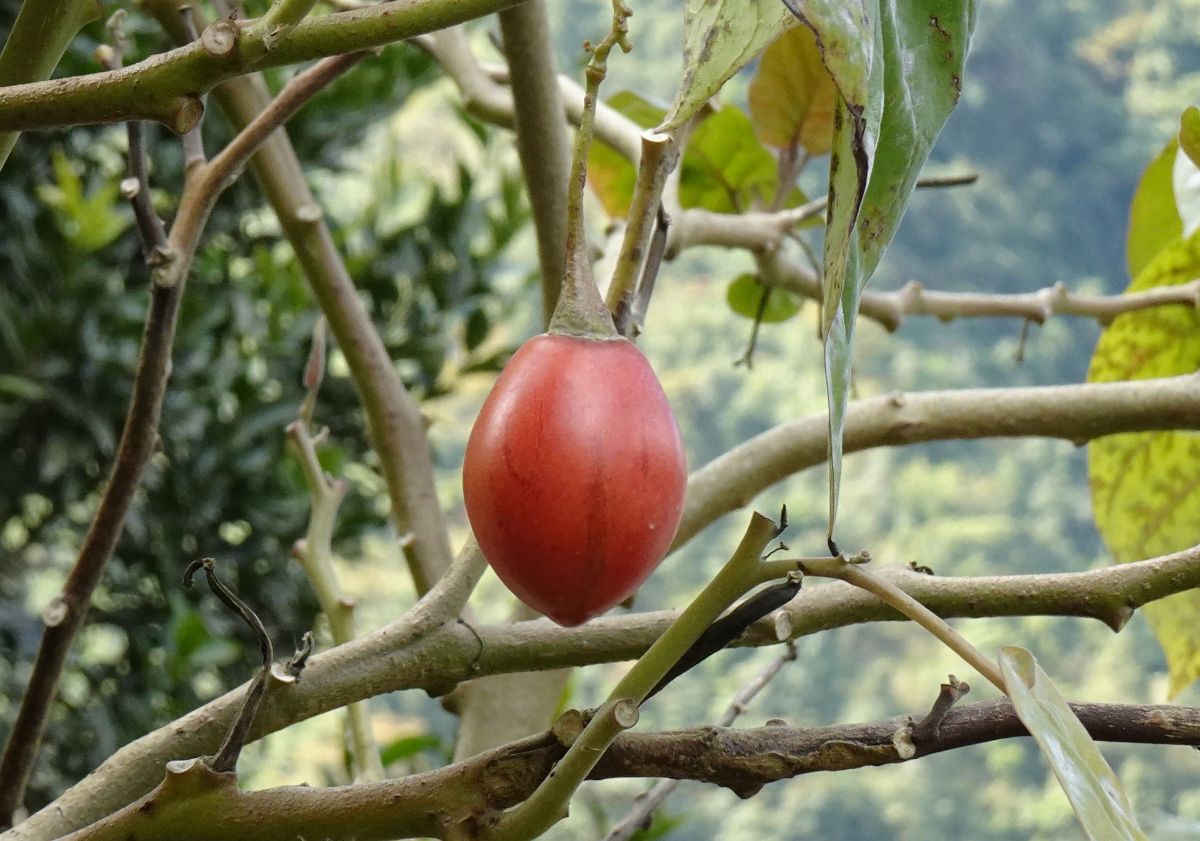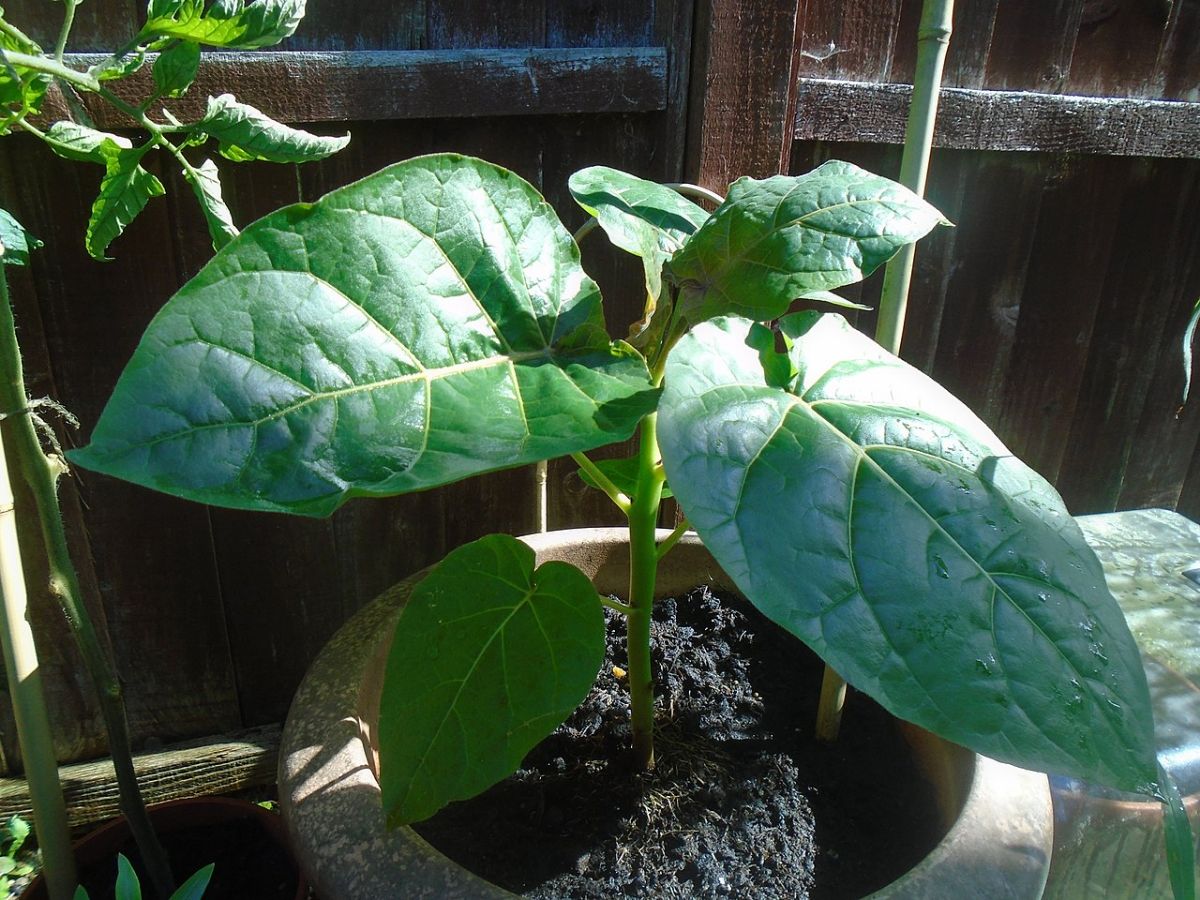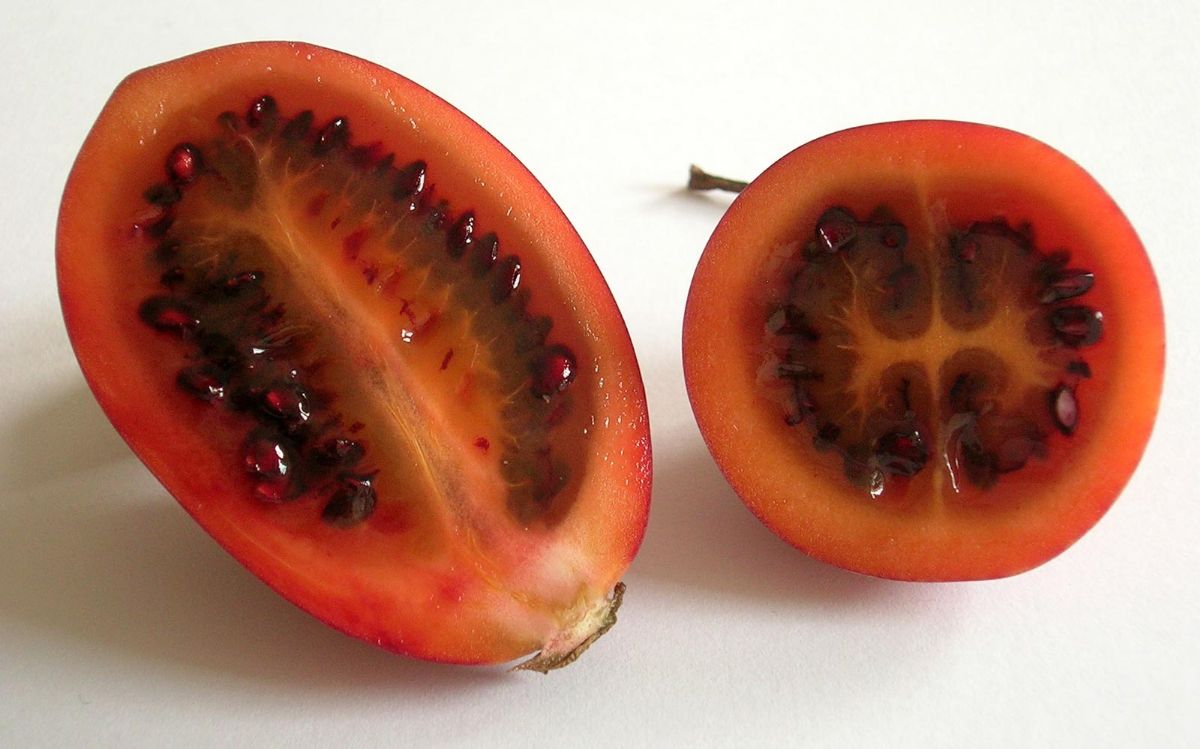
You like tomatoes? The truth is that whether they are in a salad or on toast, for example, they are delicious. But surely you are used to seeing, or maybe even growing, rather herbaceous plants. But what if I told you that there is a variety that is more of a tree? That is the tamarillo, although it is also known as tree tomato.
If you want to know it, do not hesitate: here you will find all the necessary information to cultivate it properly.
Origin and characteristics

Our protagonist is a evergreen shrub or small tree native to Latin America, specifically from Peru, Bolivia, Ecuador, Argentina and Venezuela that reaches a height of 3 to 4 meters. Its scientific name is Solanum betaceum, but it is popularly known as Andean tomato, serrano tomato, cassava tomato, tree tomato, Nordic mango, eggplant or tamarillo.
Its leaves are alternate, entire, with a robust petiole, and are 4 to 8 cm long, dark green in color and rough to the touch. The flowers are small 1,3 to 1,5 cm in diameter, pinkish-white, and are grouped in terminal clusters. These appear in spring (May to June in the northern hemisphere).
El fruit is an ovoid berry 4 to 8 cm by 3-5 cm wide, with smooth red or orange skin when ripe. It is eatable; in fact they can be eaten raw or cooked to prepare sweets and desserts. They are rich in iron, potassium, magnesium, phosphorus, and vitamins A, C, and E.
How is the tamarillo different from tomatoes?
Do you have doubts because you do not know how they can differ? Although in the description of this plant you have already been able to intuit something, because at first glance the tomato plant and the tamarillo plant are very different, there are also differences in their fruits.
Specific:
- La tamarillo plant is much bulkier and larger, reaching thick trunks and quite high.
- The tomato plant is actually a herbaceous plant, while the tamarillo is semi-woody.
- The fruit of the tamarillo, in case you have never tried it before, is very more bittersweet and fruity. It's not like tomato.
What are their cares?

If you want to have a copy, we recommend that you provide it with the following care:
Location
Outside, in semi-shade. The reason is that he doesn't like too much sun in general. Neither does the light. For the tree tomato, the best is a place where it is in semi-shade or even in full shade. And if there are also many cloudy days where you place it, much better.
Temperature
The tamarillo is an almost all-terrain plant. And it is that It adapts well to any climate and can be grown up to 2500 meters above sea level. You can have it in both hot and cold weather.
Now, you have to keep in mind that it is not its natural habitat, and that it will be difficult for it to start when it is in low temperatures.
In fact his Ideal temperature is between 15 and 20 degrees. Below, it tolerates light frosts, with up to -2 degrees. In the case of high temperatures, it can tolerate them, although the more they rise, the more problems it may have.
Another point to note is that this plant needs rainfall that reaches more than 600 mm per year (more than 600 liters per square meter).
Earth
Here we have to differentiate the soil that you will use in the garden from the one that you can use in a pot. But what both do agree on is that it needs a loose and aerated soil, with good drainage.
La soil is better if it has a somewhat acidic pH and is very nutritious (in organic matter). At the beginning, instead of applying organic fertilizers, it is better to opt for very fertile land to cover all its needs and, as time goes by, apply fertilizers.
To summarize, here is the difference between a pot and a garden:
- Flowerpot: universal culture substrate mixed with 30% perlite.
- Yard: fertile, with good drainage.
Irrigation
Every 2 days in summer, and every 4-5 days the rest of the year.
The tomato tree is a plant that does not tolerate drought at all. Therefore, if you want to plant it in your garden, you must bear in mind that dry weather and infertile soil is the worst thing you can give it.
If you live in an area with a cold or temperate climate, but with ambient humidity, you can limit watering to only when you need it or you see that the soil is drying out.
But if you are in a warm area, then the risk is better to be more continuous to avoid suffering from lack of water. In fact, it is recommended for this plant that a drip or exudation irrigation system be used to keep it constant (and thus avoid this problem).
Subscriber
From spring to the end of summer with ecological fertilizers.
El Peruvian tomato needs many nutrients, and that is why the subscriber is so important.
Experts recommend that the first fertilization should be done before planting it in the garden or in a pot. Specifically, you have to prepare the space and then add fertilizer, but without the plant. Then you have to leave between 2 and 4 weeks of time before planting it because that way the fertilizer is mineralized and achieves better effects.
After planting it can be carried out from spring to summer, although others say that it must be fertilized every 3-6 months with organic matter around the plant, and if possible mixing it with the most superficial soil. Remember that the roots of the tree tomato are superficial and will be close to that fertilizer.
Pruning
Usually, the pruning of the tamarillo is reduced to one of constant maintenance. This tree should have a low crown and a glass shape, so you will have to prune it several times throughout the year.
When the specimen is young, it will grow much faster. But in its adult stage it slows down (because it prioritizes the fruits) so it is possible that 1-2 times a year is enough.
Plagues and diseases
In this case you will have to put a thousand eyes on the fruit flies and the aphids because they are two of the pests that most affect them. To solve the problem, it is best to apply neem oil on the plant and you will end the problem.
Multiplication

By seeds in spring. Direct sowing in seedbed.
In fact, the tamarillo can also be multiplied through cuttings, but it is the sowing that gives the best results.
To do this, you have to obtain a tamarillo because each of its fruits has between 300 and 500 seeds.
These, planted in a seedbed, or in the same land, have a high degree of germination, so you will not have a problem. Even so, we give you the steps:
- Prepare the seedbed with a soil that is nutritious and maintains moisture.
- Scoop out the seeds from the fruit. You will have to leave them in a glass or a container with water for 2 days so that they decompose and eliminate the soft tissues (those that cover the seed) because this way we will avoid germination problems.
- After two days you can strain them and clean them. It is best to place them on a napkin and then apply another on top to dry them.
- When you have them, you can put them in the seedbeds, water them with a spray and wait for them to germinate.
- The plants should be left in the seedbed until they are about 5cm tall. At that time you have to plant them in individual pots of at least 5 liters. You will have to fill it with a good substrate.
- Of course, be careful when handling them because the specimens are very delicate and can break easily.
- You have to place the pot in a semi-shaded area until they measure 50 cm, at which point you can decide whether to plant it in the ground or move it to another pot.
Rusticity
It is sensitive to cold. The minimum temperature it supports is 10ºC. As it prefers shade and low light, it can be kept indoors.
What did you think of the tamarillo?
MONICA. What a joy to know that there are people like you on this planet earth. Greetings with positive energy and if you agree, I want to contact you and exchange… Juan Sanchez, actionluzproperidad@gmail.com
HELLO
I HAVE KNOWN THIS FRUIT AND I'M GOING TO GROW IT,
PLANT-
MORE IF YOU CAN HAVE INSIDE
THE NOTE FROM UDS. VERY USEFUL
EAU2
We are glad that it has been useful to you, Ricardo 🙂
Thank you very much for the information. I have a gourmet products factory in San Rafael, Mendoza. I know the tomato of my area well. But I was curious about this one. I think its cultivation will be impossible. There are very low temperatures in winter. I appreciate your trouble.
Thanks to you for commenting, Lidia. Greetings!
What are the characteristics of the root and trunk, to know if I can plant it near a wall or in which place to do it
My yard is small
I am 47 years old turned upside down! hehe, and in the house where I was born and lived until I was 6 years old, I always remember the tomato tree that nobody believed me, until a few years ago when they gave me a tomato and now I have my beautiful tomato tree from my childhood. Thanks for the info!
Thank you for commenting, Linda. Have a lot of fun with your plant 🙂